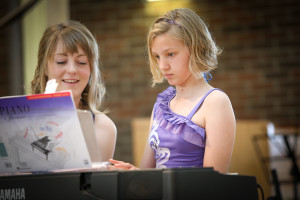 When introducing a new piece of music, play it through in its entirety – up to tempo and with all the dynamics and flourishes you hope to hear at the end of the teaching experience.
When introducing a new piece of music, play it through in its entirety – up to tempo and with all the dynamics and flourishes you hope to hear at the end of the teaching experience.- Break down the lesson into small segments (ie. taking the instrument out of the case, opening the piano lid, reviewing the previous week’s lesson etc.) Use a picture board to reflect the 5 – 6 segments in every music lesson. Having a regular and familiar opening and closing is really important for framing a successful lesson. However for diversity you may want to make changes to the framework every school year or perhaps every season. Just remember to give the child a warning notice that changes are coming…3 weeks from now, 2 weeks from now, next week….
- Include free time – this can be a time to move, improvise, sing, stretch, listen to a song on CD.
- Have a trigger for when things are going well. This could be a phrase that the teacher says and only saves for such occasion, a certain shaped sticker, a different colour that you write a note in their journal etc.
- Use hand gestures to move you through the piece instead of a metronome. This creates a more relational experience and keeps the student involved with not only the music but with you as teacher.
…and a bonus…enjoy the little moments and know that you are contributing to a child (and their families) life in a positive, meaningful way.
